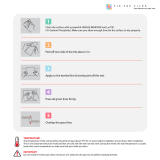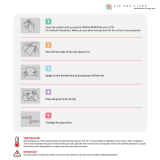
Question: What are the guidelines for setting tile on ceilings?
Answer: Only small (8" x 8" or less), lightweight tiles are appropriate for setting on ceilings. Use a premium quality, non-sag,
polymer-modified mortar and proper technique for best coverage. Tiled steam shower ceilings require additional
surface preparation with a waterproofing and vapor-proofing membrane and must have a one-way slope of 2
inches per foot as detailed in TCNA SR614.
INSTALLATION PRODUCTS TO USE
Question: What is the best way to waterproof a shower wall or tub surround?
Answer: Monolithic application of RedGard
®
Waterproofing and Crack Prevention Membrane will effectively waterproof wet
areas like shower walls and tub surrounds. Apply two coats of RedGard to the wall (continuing to the shower floor
and drain assembly if applicable). A gallon of RedGard will cover 55 square feet in two applications (apply ½ gallon
uniformly to 55 sq. ft. and repeat with remaining ½ gallon when the first coat dries). Allow the first coat to fully dry
before applying the second and make sure there are no pinholes or voids in the coating. RedGard also acts as a
vapor barrier preventing moisture vapor from entering the wall cavity behind the tile where moisturecan contribute
to mold growth.
Question: What kind of mortar should be used to set tile on walls and ceilings?
Answer: When tiling vertical or suspended surfaces, it is important to use a mortar that has excellent non-sag qualities.
These mortars are designated by ANSI with the letter “T” after the standards number. ProLite
®
Premium Large
Format Tile Mortar exceeds the requirements of ANSI A118.15T and is formulated to support the weight of large
and heavy tiles on walls. ProLite weighs 40% less than typical mortars and helps reduce overall load bearing
created by tile installation.
Question: What about the needs of glass tile?
Answer: Glass Tile Premium Thin-set Mortar is highly polymer-modified to bond to the smooth surface of glass. Its flexibility
is designed to accommodate the extra movement of glass tile, which is sensitive to thermal changes. The bright
white color offers a clean, uniform appearance when installing clear or translucent glass tile.
Question: Are installation needs different on exterior versus interior applications?
Answer: Yes, exterior tile assemblies are subject to much wider temperature swings and in most cases more prolonged
water exposure than interior tile installations. The proper mortar should be selected for these demanding exterior
installations that experience freeze/thaw cycles and other thermal fluctuations. Use ProLite or MegaLite
®
Ultimate
Crack Prevention Large Format Tile Mortar, which also exceeds the non-sag requirements of ANSI A118.15T.
Tiles installed in exterior and/or wet applications must be backbuttered to achieve the required 95% mortar
coverage to the back of the tile. Movement joints should be placed every 8-10 feet in the tile assembly with a
flexible sealant like Commercial 100% Silicone Caulk. Liquid-applied RedGard can mitigate efflorescence due to
moisture migration in exterior tile and grout, and help protect the building envelope from water intrusion through
the tile assembly.
Question: Do walls require special grout?
Answer: Walls can be stained by accidental splashes and it is important to use a stain resistant grout like Fusion Pro
®
Single
Component
®
Grout. Epoxy grout can be used, but should be protected from strong UV light, as the color will shift.
In extremely wet environments, a cement grout, like Prism
®
Color Consistent Grout, is the best choice and can be
sealed against staining with Aqua Mix
®
Sealer’s Choice
®
Gold.
CustomBuildingProducts.com
|
800-272-8786
The information in this document is presented in good faith, but no warranty, express or implied, is given nor is freedom from any patent in as much as any assistance furnished by CUSTOM with reference to
the safe use and disposal of its products provided without charge. Custom Building Products assumes no obligation or liability therefore, except to the extent that any such assistance shall be given in good
faith. Product specifications subject to change. Visit CustomBuildingProducts.com for updated technical data sheets and MSDS information.
©Custom Building Products 2016
FAQWA 6/16R
For additional information, visit CustomBuildingProducts.com or call
CUSTOM Technical Services at 800.282.8786.













